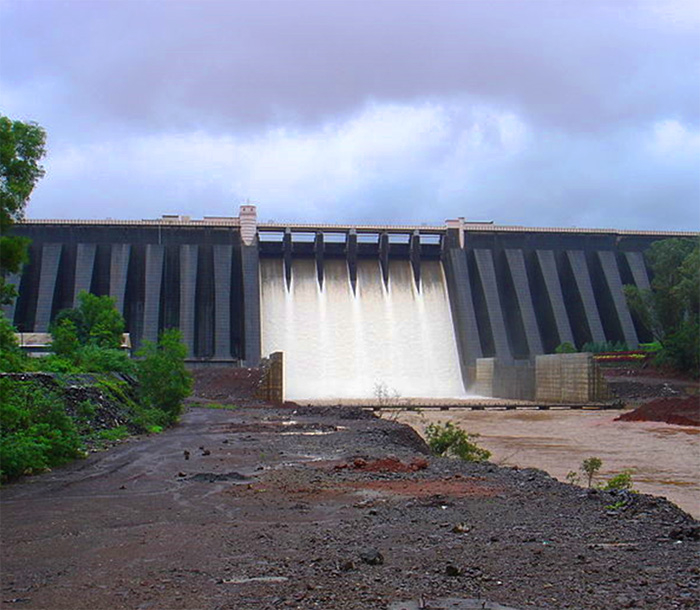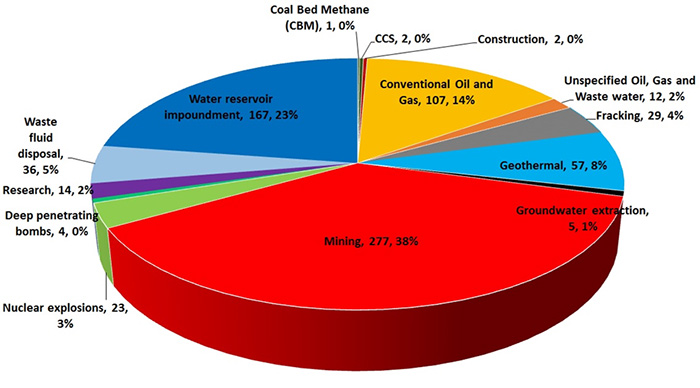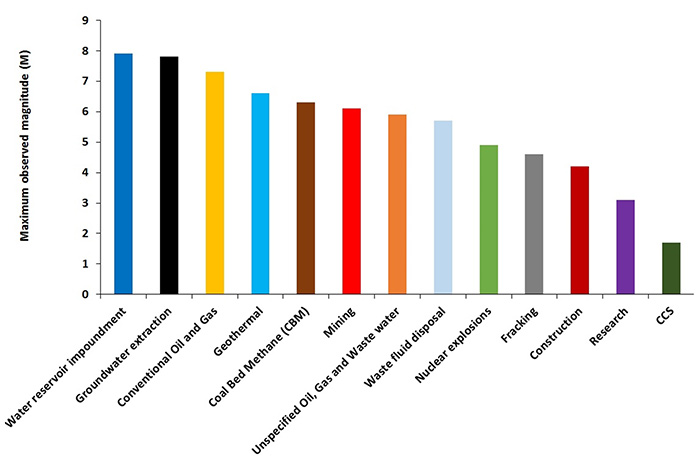
The Earth has 3 million earthquakes a year, 8,000 every day. And some are caused by humans.
The crust of the Earth is composed of many tectonic plates, which are always moving.
As the plate boundaries collide, grind against, or pull apart from each other, the crust cracks, creating fault zones.
As stress builds up, the plate boundary faults can open or slide, causing natural earthquakes. The vast majority are too small to feel, but some can be major.
Sometimes human activities can trigger an earthquake, causing a fault to move earlier than it naturally would. In 2017, some British scientists decided to catalogue these.
They found that about half were due to extraction—of mining products, groundwater, or oil. Removal of material changes the stress, which can cause faults to move.
Another quarter were caused by loading the Earth’s surface where it was not loaded before, such as reservoirs held behind dams, which can add stress to faults.
The last quarter happen when fluids produced from the Earth are injected back into it, like in a disposal well, where wastewater from oil or gas production changes the pressure conditions, sometimes causing the fault to slip.
This last type gets a lot of attention these days, and we’re studying it extensively at the Bureau of Economic Geology, where I work.
Ever since humans have had large-scale industrial processes we’ve been interacting with Earth’s natural earthquake cycle … in ways we’re just now coming to understand.
Background
Synopsis: Earthquakes are powerful releases of energy beneath Earth’s surface. But did you know that human activities also have the power to cause earthquakes?
- Earth’s crust is like a fragile eggshell that covers our dynamic planet.
- It is cracked along plate boundaries, where it might be pulled apart by tensional forces, crushed together by compression, or slid laterally by translation as plates grind against each other side-by-side in opposite directions.
- Earth’s crust is stressed everywhere by tectonic forces, even in the center of big plates like the North American Plate. These stresses vary in direction and strength both vertically and horizontally.
- We measure stress in the crust with wells drilled deep into the earth for energy resources or research.
- A delicate balance exists between rock strength, fluid pressure, and the direction and magnitude of stress in the earth at any given time.
- It is sometimes possible for fluid injection or mining activities to upset this balance and trigger earthquakes on faults that might not move in a naturally occurring earthquake for thousands of years.
- The earth is covered with faults, large and small, some active today as Earth’s crust slowly deforms over geologic time.
- Naturally occurring earthquakes occur when stresses build up to the point that they overcome resistance to slip.
- The U.S. Geological Survey estimates that more than 3 million earthquakes occur every year—that’s 8,000 earthquakes a day. But the vast majority of these quakes are so small that we can’t feel them.
- Earthquake size can be measured in a variety of ways, but we usually talk about their magnitude. In most cases, crustal earthquakes over a magnitude of 3 can be felt by people in the area.
- Large and damaging earthquakes are extremely rare and usually occur at plate boundaries. As earthquake size increases, the frequency of their occurrence decreases. For example, with every magnitude 6 earthquake (the size at which some damage could be expected) in an area, about 1,000 magnitude 3 earthquakes occur.
- In 2017, UK researchers released the Human-Induced Earthquake Database, cataloging all anthropogenic seismicity—documentable earthquake activity that might be attributed, at least in part, to human activity. Results show that four main types of human activity may cause seismicity.
- The most common cause is extracting material from the subsurface—more than 50% of anthropogenic seismic events are attributed to mining or extraction of groundwater, oil, and gas. Removing the weight of overlying materials, which normally clamp faults shut, enables faults under stress to move more easily.
- Mining processes account for 38%. Mining leaves caverns at the surface and deep within the earth that change stress states, causing chambers to collapse and faults to fail. (The same process occurs naturally in sinkholes.) In 2007 alone, more than 100 mines in China reported seismic events larger than magnitude 4.
- Irrigation-water extraction was related to just a few, but strong, events. Groundwater occupies tiny voids in porous aquifers and helps to support the matrix of grains in the aquifer rock under the huge weight of the overlying rock. When water is extracted, fluid pressures drop and stresses in the earth change, potentially causing ground subsidence or fault reactivation. In 2011, a 5.1 magnitude earthquake that killed 10 people was attributed to decades of irrigation water production; obvious ground subsidence was evident at the site of the quake in the Spanish town of Lorca.
- Extraction of oil and gas from conventional hydrocarbon production was attributed to 15% of the events in the database. Earthquakes also have been reported during traffic and train tunnel excavation.
- The second-most common cause is loading the surface of Earth where it was not loaded before—changing stress states deep in the earth because of increased overburden, thus influencing shear stress on deep fault planes.
- Impounding water reservoirs is responsible for 23% of anthropogenic events; tremors have been correlated with the timing of reservoir operations at more than 70 dams. Adding a body of water to the underlying geology can cause seismicity by increasing fluid pressure or changing stress distribution through direct loading of the water column, or both.
- In November 1981, a magnitude 5.7 earthquake occurred that was related to the filling of Lake Aswan behind the Aswan Dam along the Nile River in Egypt. Hundreds of earthquakes have occurred that were correlated to water-level fluctuations and geologic fault traces.
- In December 1967, a 6.3 magnitude earthquake occurred near the Koyna Dam in the western Indian state of Maharashtra, killing around 180 people and injuring more than 1500.
- The Koyna Hydroelectric Project includes four dams that impound Shivsagar Lake, which is more than 30 miles long. The reservoir plays a major role in flood control during monsoon season, in addition to power generation and local irrigation.
- No reports of seismicity in this area of India’s Deccan Traps—massive mile thick layers of basalt that cover almost 200,000 mi2—occurred before the lake’s filling in 1962. Since then, earthquakes have been happening in a 12 x 24 mile area each year in the months of June and July. More than 20 magnitude 5 earthquakes, more than 200 magnitude 4 earthquakes, and 1000s of smaller tremors have occurred.
- Seismicity related to loading the earth has also been documented for skyscrapers and large coastal structures.
- Impounding water reservoirs is responsible for 23% of anthropogenic events; tremors have been correlated with the timing of reservoir operations at more than 70 dams. Adding a body of water to the underlying geology can cause seismicity by increasing fluid pressure or changing stress distribution through direct loading of the water column, or both.
- Injecting fluid underground also creates seismicity as fluid pressures become elevated, changing the balance of stresses in the subsurface. (We will talk more about injection-related seismicity in future episodes of EarthDate.)
- Injection activities, which account for 21% of anthropogenic earthquakes, occur during wastewater disposal from industrial processes, conventional enhanced oil recovery (EOR), reservoir stimulation from hydrofracturing (“fracking”), reservoir stimulation related to enhanced geothermal systems (EGS), injection research projects, and underground storage projects for carbon or gas.
- In recent years, seismicity has increased dramatically in areas near sites where large quantities of industrial wastewater are injected underground.
- Injection activities, which account for 21% of anthropogenic earthquakes, occur during wastewater disposal from industrial processes, conventional enhanced oil recovery (EOR), reservoir stimulation from hydrofracturing (“fracking”), reservoir stimulation related to enhanced geothermal systems (EGS), injection research projects, and underground storage projects for carbon or gas.
- Wastewater may come from conventional hydrocarbon production—output from oil wells can be more than 90% salty water that must be disposed of.
- Wastewater may also come from the process of fracking, which uses water pressure and sand to open cracks in less-permeable rocks underground, allowing hydrocarbons to flow out of them. (Fracking itself can also cause earthquakes, but they are usually of lower magnitude than those related to wastewater injection.)
- The largest earthquake related to wastewater injection had a magnitude of 5.8 and took place in Pawnee, Oklahoma, in September 2016, resulting mainly in nonstructural façade damage.
- In the Mediterranean, off the coast of Spain, the Castor Gas Storage Project started operations in the fall of 2013. Within 40 days, more than 1,000 seismic events with magnitudes between 0.7 and 4.3 were recorded. The facility was shut down in response to concerns of local residents, but another magnitude 4.3 quake occurred a month later.
- Finally, explosions from underground bomb and nuclear tests produce earthquakes with particular signatures that enable scientists to distinguish them from natural earthquakes.



